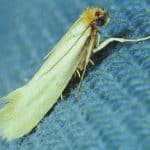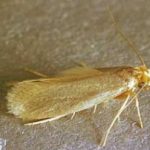Votre panier est actuellement vide !

The textile moth
In Quebec, the moth is commonly called « moth ».moths are tiny butterflies (about 6 mm) commonly called mothsThey have hairs or scales on their headTheir wings are narrow, lined with long bristlesThe wings are golden or brownish and spottedTwo species attack clothes stored in homes: the clothes moth and the case moth
Nom Latin: Tineola bisselliella
Description:In Quebec, the moth is commonly called « moth ».Moths are tiny butterflies (about 6 mm) commonly called mothshave hair or scales on their headsTheir wings are narrow, lined with long bristlesWings are golden or brownish and spottedTwo species attack clothing stored in homes:the clothes moth and the case moth.
Production:They are nocturnal moths.The females lay eggs in the dust of closets, or they fix thements on the fibers of a fabric with a gelatinous material.Small caterpillars emerge after a few days, because the egg stage can not survive the winter. The caterpillar makes a silk tunnel that covers the fabric where it feeds, or it builds a silk sheath that it carries with it.The caterpillar then makes a silk sheath for metamorphosis, or it uses the one it was carrying, and installs it in the crack of a wall or a ceiling. The caterpillar can live without food for some time, and it can take several weeks or more than three years from the caterpillar stage to the winged adult stage. The male lives for several more weeks during which time he continues to mate.All males can fly, as opposed to only a few females.The other adults will run or jump instead.
Habits:The flying adult is rarely observed since it is active at night. The source of infestation will be found in an undisturbed area such as a box containing fabrics that have been stored for a long time or clothes that are not worn often.The moths possess, in their caterpillar state, enzymes that allow them to digest keratin. This protein is found in hair, fur, feathers, horns, hooves and nails. Inside the home, caterpillars infest blankets and pillows as well as clothing, preferring animal materials such as woolens, but can also bore holes in cotton and linen as well as synthetic fabrics soaked with sweat, food or grease from hair. They also attack grains, dairy products, meat, cayenne pepper and ginger. In the wild, they feed on pollen, ticks, dead insects, animal carcasses and exuviae (old skins) of garter snakes. They can also be found in bird nests, wild bee shelters or under bark.The carpet moth, in the caterpillar stage, burrows into carpets, upholstery and furniture stuffing, while the two clothes moths live on the surface of fabrics.
Prevention:Install screens on doors and windows so that moths can’t enter the house. Vacuum cracks in the floor and everywhere, even under furniture that isn’t moved often and on pipes (such as air ducts).Inspect clothing storage areas for hidden moths.Check for holes in clothing or droppings left by caterpillars.Also check for silk tubes under the carpet.Before storing fabrics, clothing, blankets or pillows, it is best to wash and iron them. Before storing fabrics, clothing, blankets or pillows, it is best to wash and iron them. You can place them in containers (or a large plastic bag) sealed with tape. In the past, mothballs or cadichlorobenzene crystals were suggested, but to avoid human health effects, some recommend scented bars of soap or lavender flower sachets. Used clothing should be inspected before being brought into the home, and should be stored separately from new clothing. Clothing that is not washed at each use, such as woollens, should not be stored in dark closets. It has been shown that caterpillars cannot complete their development if only clean woollens are available; however, woollens are seldom sufficiently clean to be safe from these insects. Vitamin B, found in human sweat, is thought to be necessary for their growth. The stains (juice, urine, perspiration) would also allow them to obtain the salts they need. From time to time, it is a good idea to hang woolens outside to be shaken and brushed.Carpets and furs should also be monitored or steam cleaned.
TO NOTE:Many people believe that mothballs (mothballs) as well as paradichlorobenzene REPEL insects, but this is false. If these products are placed inside a garment bag or a box sealed with tape, the vapors will reach the level of toxicity necessary to kill moths and young larvae but will not affect other stages of development. Camphor (natural or synthetic) would be a real repellent and less toxic to us, but its effectiveness in killing moths would be a little lower than the other two products, and cedar oil cannot be considered a repellent, but it does act on very young larvae. The fact that a chemical product has been known and used for a long time and is readily available does not necessarily mean that it is completely harmless to humans. Mothballs have already caused, among other things, the contamination of a fetus following exposure of the mother, as well as systemic reactions (in the whole body) in children following the wearing of clothes that had been stored with this product. Some authors now suggest that paradichlorobenzene should be avoided, as it could cause cancer. It should be noted that insecticides commonly sold as sprays are not a guarantee of quality for domestic use. It would be preferable to use a professional exterminator in order to know which products are appropriate for the type of insect to be eliminated.
